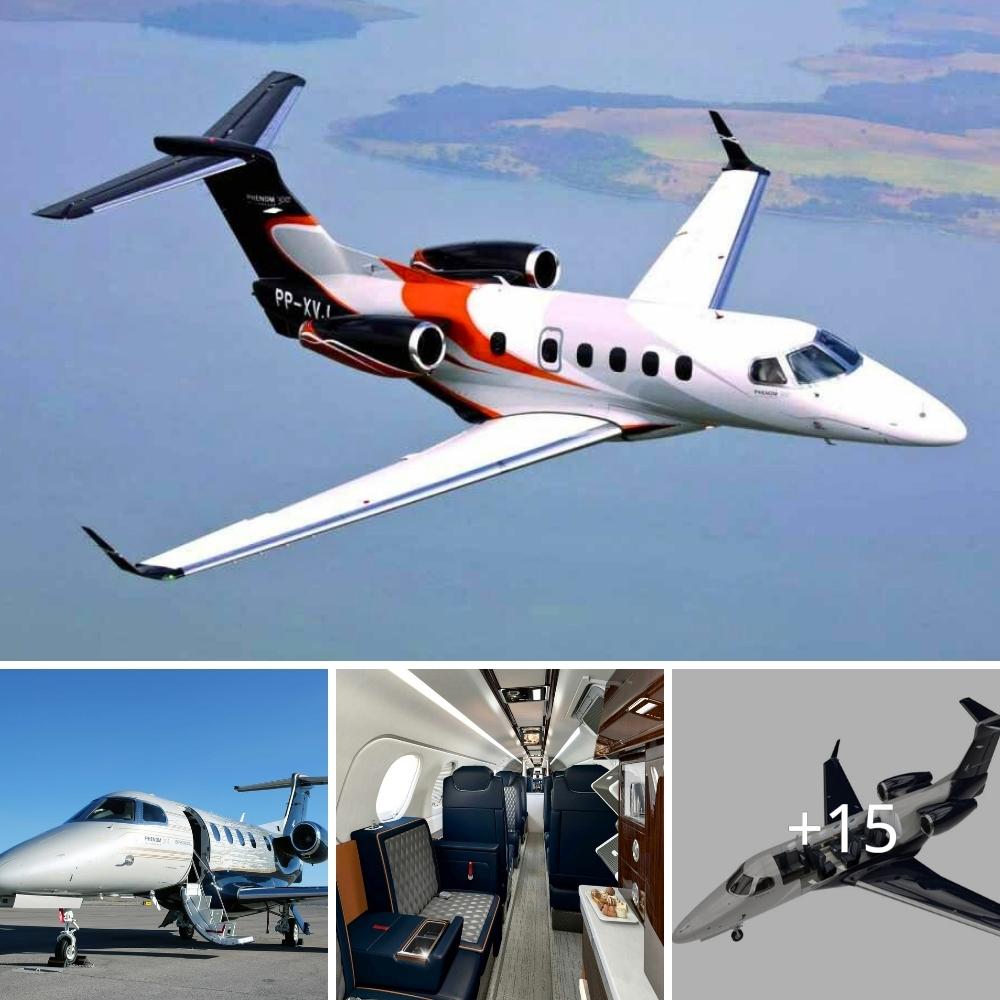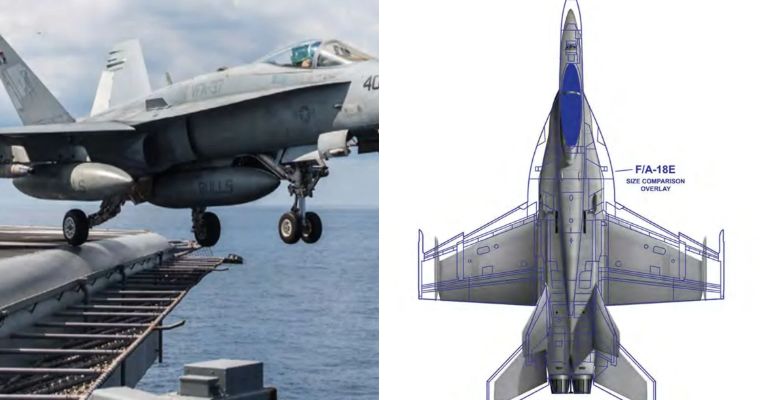Boeing has unveiled its ‘Modernized Apache’ that can carry more weapons, has increased range and speed, and other improvements.
oeing has announced a new Modernized Apache attack helicopter concept that builds off the V6 subvariant of the AH-64E Apache Guardian. What’s most immediately eye-catching is the additional hardpoint under each of its two stub wings, giving it six in total, under which it can carry directed-energy weapons and air-launched drones, among other stores. The company says the next-generation Apache design will also feature powertrain improvements for increased speed and range, improved sensor fusion capabilities and greater general situational awareness, and other upgrades.
The Modernized Apache’s unveiling comes as the Association of the U.S. Army (AUSA) kicks off its main annual convention and trade show in Washington, D.C., today. The U.S. Army is currently pushing ahead with a major modernization effort, called Future Vertical Lift (FVL), which aims to acquire a number of different next-generation rotary-wing aircraft, including a new armed scout helicopter. However, the Army expects to continue operating various existing types, including hundreds of Apaches, for at least another 25 to 30 years.
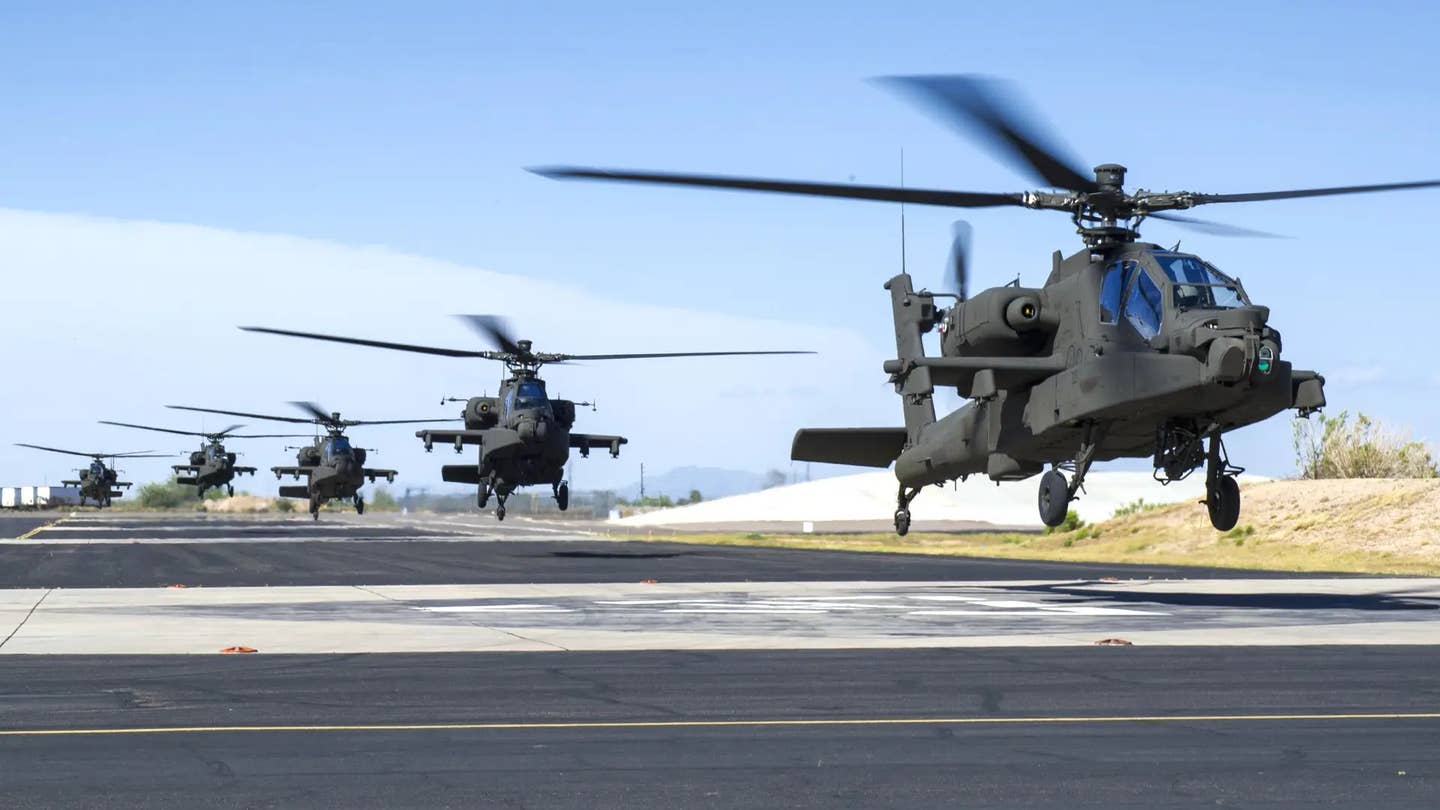 US Army AH-64 Apache attack helicopters. US Army
US Army AH-64 Apache attack helicopters. US Army
“The Modernized Apache concept is capable of seamlessly and effectively meeting the Army’s evolving attack and reconnaissance requirements – including increased agility, interoperability, lethality, survivability and reach,” according to a press release Boeing issued today. “It also leverages, protects and preserves the established, worldwide industrial base already mature and in place to support future Apache engineering, manufacturing, development and production.”
The press release breaks the improvements found on the Modernized Apache into the following six categories:
1. Drivetrain upgrades to unlock Improved Turbine Engine (ITE) capabilities for enhanced power, range, efficiency and speed
2. A Modular Open Systems Approach (MOSA) for maximum interoperability, and faster integration and fielding of advanced capabilities
3. Advanced mission systems to increase interoperability to the network and to reduce pilot cognitive strain and workload during operations
4. Advanced sensors and sensor fusion for better and more resilient connectivity across domains and operations in all environmental conditions
5. Airborne long-range precision munitions, Air Launched Effects (ALE) and potential future directed energy weapon system integration for increased lethality
6. Advanced sustainment through a more capable and lower life cycle cost airframe, as well as affordable remanufacture and minimized procurement costs
Curiously, there is no specific mention in the press release about the Modernized Apache’s extended stub wings. Concept art that Boeing also released today depicts examples of the improved helicopter carrying what looks to be an M310 twin-rail launcher loaded with two tubular launch containers for unknown munitions on the new left outboard station, and a pod of some kind on the right one. The Apaches are all also shown loaded with what appear to be 16 Hellfire missiles on four-rail launchers, two under each stub wing.
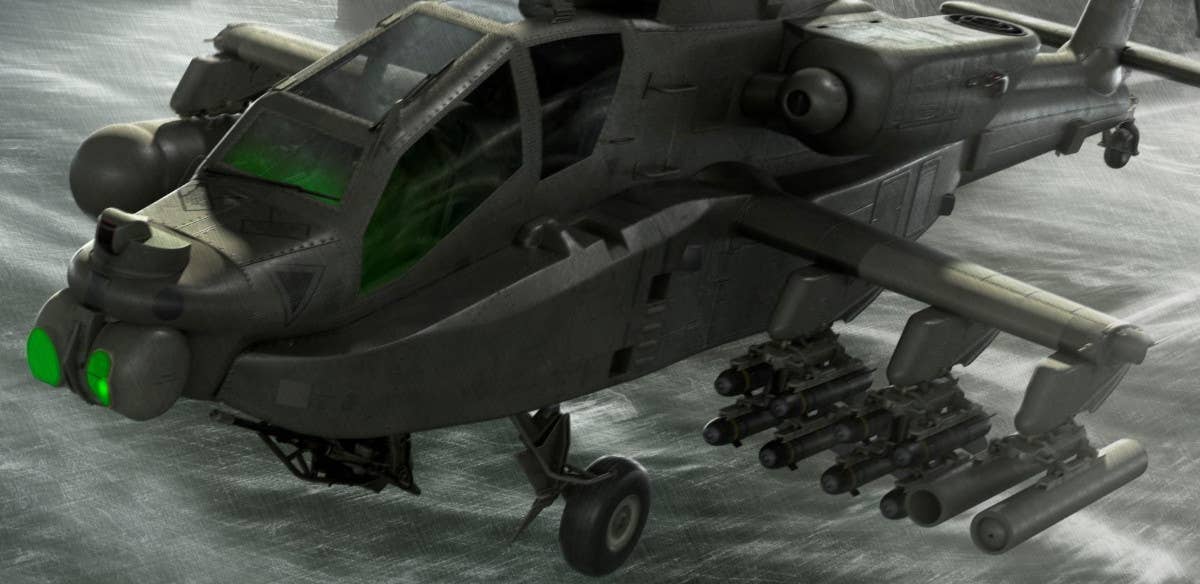
A close-up look at one of the Modernized Apaches in the concept art Boeing released today, showing the various stores on its extended stub wings. Boeing
The tubular launch containers most likely represent Common Launch Tubes (CLT), which can be loaded with various munitions, as well as air-launched drones. The pod looks very much like one from Raytheon that contains a solid-state high-energy laser directed energy weapon that has been demonstrated on the Apache in the past. Though it seems less likely due to its size and shape, the ‘pod’ could also potentially be a range-extending external fuel tank.
CLTs and a podded laser would all be in line with Boeing’s press release stating that a key aspect of the Modernized Apache is the ability to employ “Air Launched Effects (ALE) and potential future directed energy weapon system integration.” The U.S. Army is looking to acquire a family of air-launched drone systems, which it refers to collectively as ALEs and that will be able to carry out a wide variety of tasks as part of autonomous networked swarms.
ALEs, which could act as decoys or stand-in jammers, as well as loitering munitions – also known as ‘suicide drones’ – capable of engaging pop-up threats, could help older helicopter designs like the Apache be more survivable. In addition to offering additional ways to suppress or neutralize hostile enemy air defense systems, the air-launched uncrewed systems would give AH-64s additional reach while allowing them to operate further away from known hazards.
You can read more about the ALE program and the capabilities it has already demonstrated here.
In addition, the concept art shows what appears to be either a new mast-mounted radar sensor, or at least a revised radome for the existing AN/APG-78 Longbow radar. An improved radar could increase the range at which targets or other threats might be detected and engaged, as well as the fidelity of those tracks. This would be an important addition when combined with longer-range munitions.

Boeing
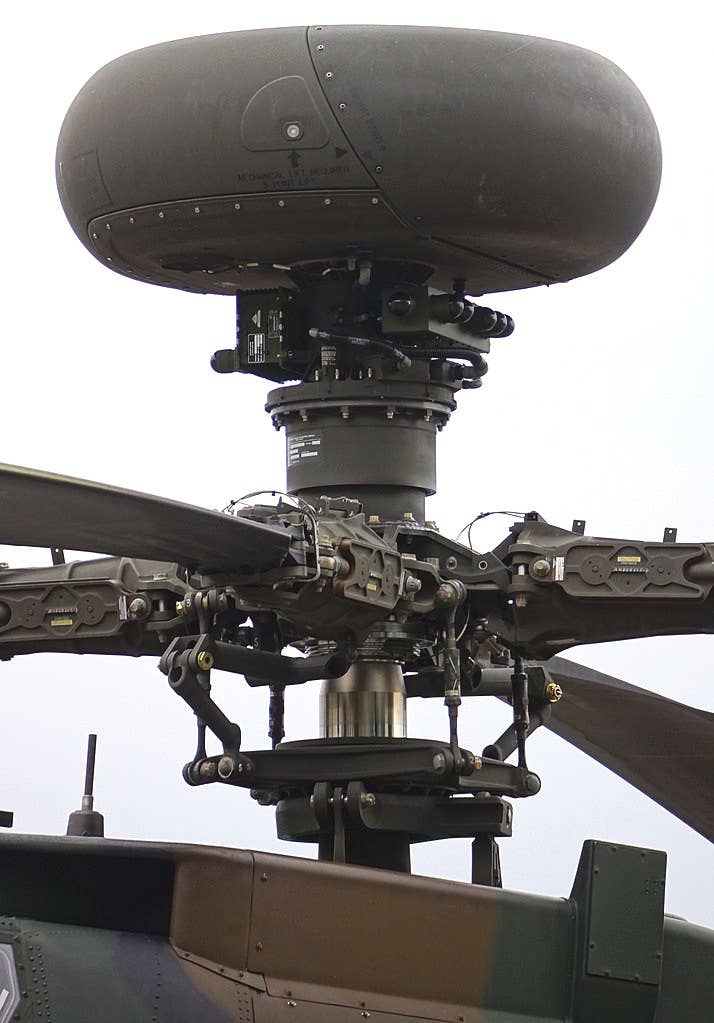
An example of the current AN/APG-78 Longbow mast-mounted radar for the Apache, seen here on a Japanese AH-64. Hunini via Wikimedia
There are changes to the design of the upswept engine exhausts, as seen below, as well. This is all but certainly intended to help further reduce the helicopter’s infrared signature.
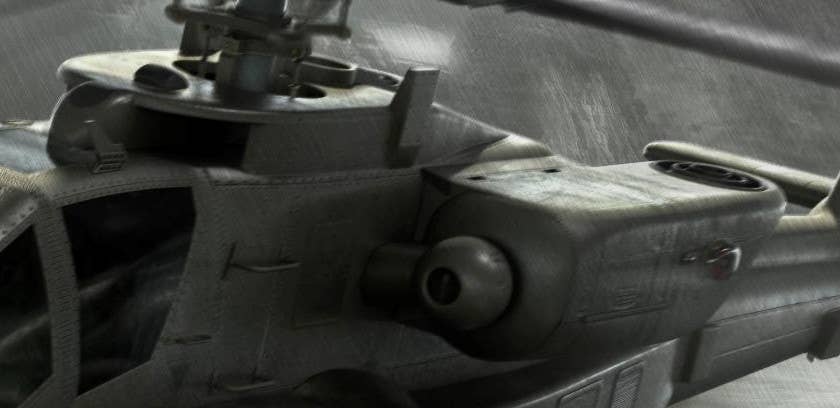
Boeing
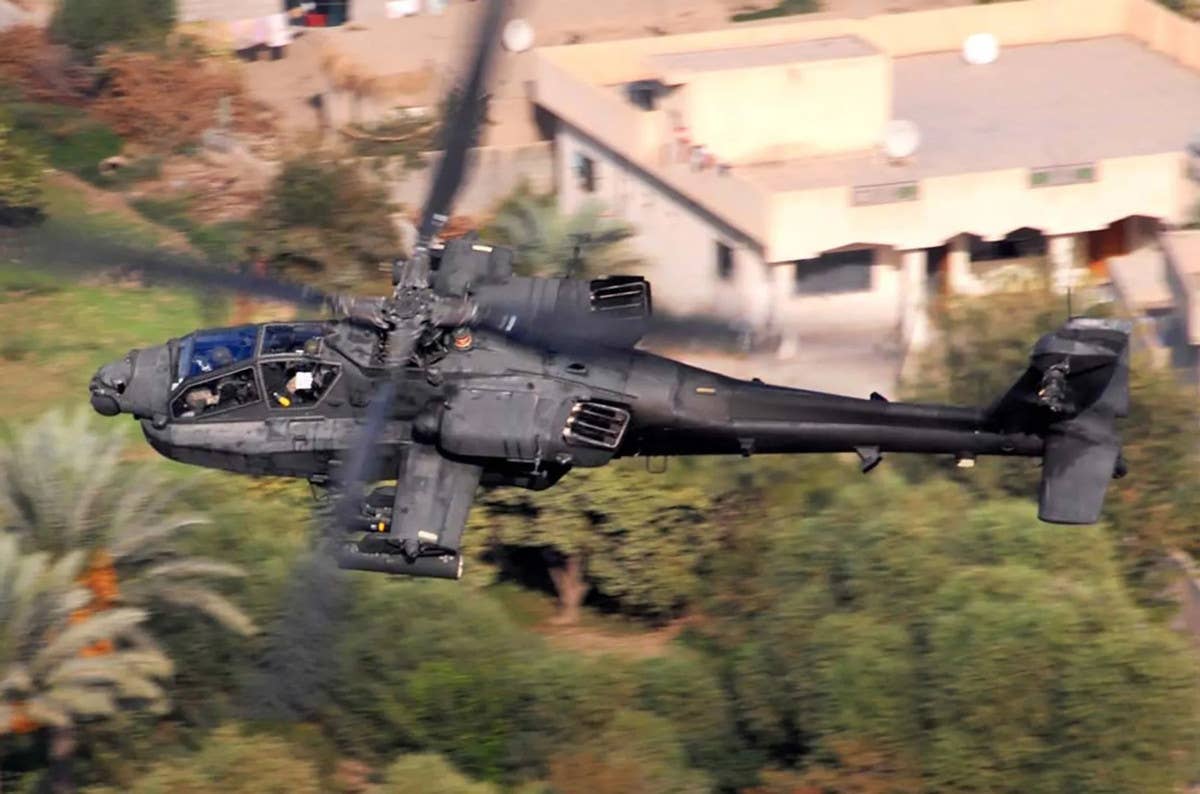
A picture of a US Army AH-64 offering a good look at the current standard upswept engine exhaust configuration. US Army
It’s not immediately clear whether or not the Modernized Apaches depicted in the concept art have some type of directional infrared countermeasures system (DIRCM). DIRCMs typically use an array of sensors to detect incoming heat-seeking threats, and then use relatively small turreted lasers to blind and confuse the seekers on those incoming weapons, throwing them off course. Various types of DIRCMs have been used on U.S. Army and foreign Apaches over the years, and the Army eventually hopes to integrate a version of its Common Infrared Countermeasures (CIRCM) system onto its AH-64s.
Improved infrared-signature-reducing exhausts coupled with a DIRCM system, as well as other countermeasures, would help protect it against ever-improving heat-seeking anti-aircraft missiles, especially next-generation types of shoulder-fired surface-to-air missiles, a category of weapons also referred to as man-portable air defense systems (MANPADS). This might help the helicopter better evade detection via passive infrared sensors, too.
Boeing’s press release does not provide more specific details about the Modernized Apache’s improved sensor and networking capabilities, or its underlying MOSA architecture, but these have long been areas of interest to the Army. The AH-64E V6 configuration already integrated new sensor and data-sharing systems, as you can read more about here. Modular, open-architecture physical hardware and software concepts are, in general, intended to help provide a path to more easily integrate new and improved functionality as time goes on.
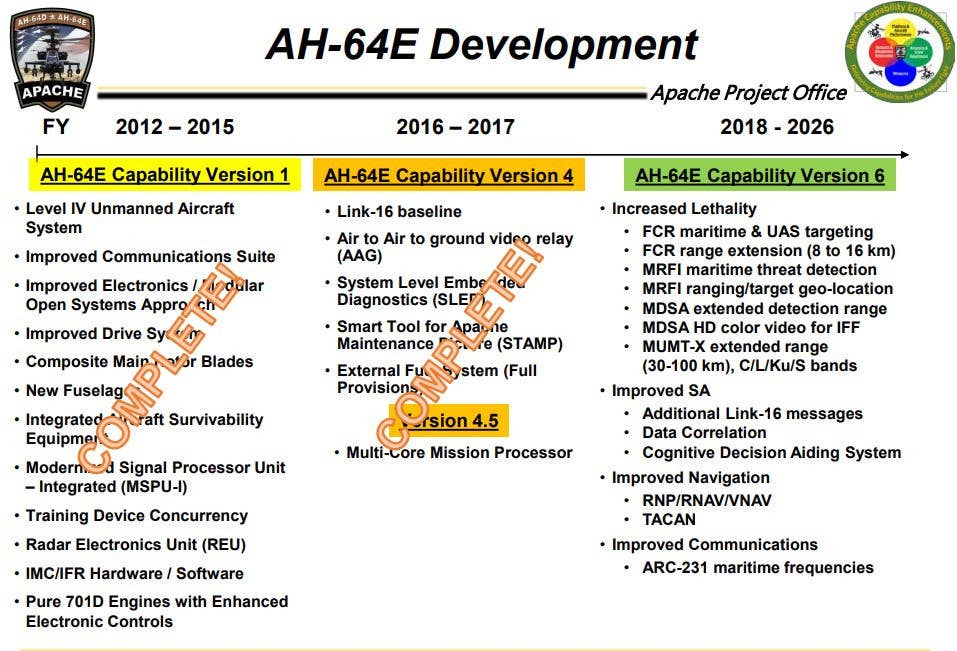
Sikorsky, now a division of Lockheed Martin, now has a different armed scout design, called RaiderX, in the running for the Army’s Future Armed Reconnaissance Aircraft (FARA) competition, which is also part of the FVL initiative. Boeing, which had pitched a compound Apache design for FARA, did not make the down-select in 2020. Sikorsky and Bell are now facing off for the FARA contract. Though Army expects to substitute hundreds of FARAs for Apaches in existing attack reconnaissance units, whatever design it picks as the winner of this competition will not be a direct replacement for the AH-64. FARA is more of a spiritual successor to the OH-58D Kiowa Warrior armed scout helicopter, which was retired in 2017 without a direct replacement.
Boeing could potentially pitch either the compound Apache or a derivative of the Defiant-related armed helicopter design to the Army again for a future requirement, but the service currently has no program of record seeking a direct AH-64 replacement. “There’s nothing right now that is on the books that’s going to replace the Apache,” Jessie Farrington, Boeing’s director of attack helicopter global sales and marketing, told reporters today at the AUSA conference, according to Breaking Defense.
In the meantime, as already noted, the Army plans to keep flying hundreds of Apaches for many years to come, which will need further upgrades to ensure they can contribute effectively in future conflicts, especially potential high-end fights against potential near-pear adversaries like China or Russia. “We’re trying to listen to what the Army’s saying about the modernization efforts and keep this as flexible as possible,” Kathleen Jolivette, Boeing’s vice president for attack helicopters, told reporters at AUSA, according to Breaking Defense.
“We believe we’re going to have to do something with the Apache in the future,” she added. “It can’t just remain where it is.”
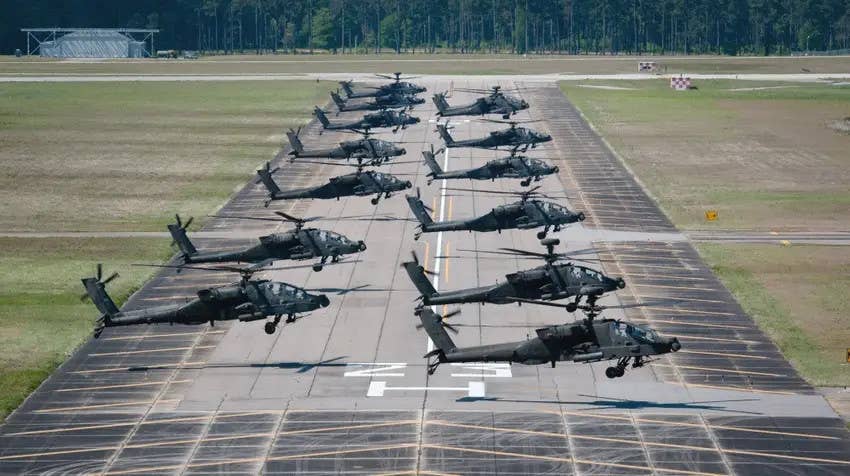
US Army
Jolivette is entirely right, but her comments reflect a growing debate about the general relevance of more traditional attack helicopters going forward, especially in any future major conflict. Russia’s ongoing war in Ukraine has underscored the very serious threats conventional helicopters face on a modern battlefield.
There are also questions about the generally limited speed and range of traditional helicopters, issues that would be magnified during any future large-scale operations in the Pacific region. The U.S. Marine Corps, as part of its radical Force Design 2030 restructuring initiative, has decided to cut a significant number of AH-1Z Viper attack helicopters, as well as UH-1Y Venom armed utility helicopters, in no small part due to these limitations.
Of course, Boeing does continue to have significant success with the Apache line on the export market, as well. The Polish government just recently announced its intention to buy 96 AH-64Es, which would give it the second-largest Apache fleet would-wide behind the U.S. Army. The Polish armed forces and other current and future foreign Apache operators could easily be interested in the improved capabilities that the Modernized Apache offers. This could be especially true if Boeing can offer some or all of the features found in this new configuration as a cost-effective upgrade package for existing AH-64s.
Altogether, the Modernized Apache is a less dramatic departure from the core AH-64 design than what Boeing has pitched in the past. At the same time, the new configuration, with its ability to carry more stores under its extended sub wings and other improvements, could still provide a significant new boost in capabilities for the U.S. Army, and other existing and future operators of the type, in the near term.
A general overview of the additional capabilities introduced to the AH-64E with the V6 upgrade package. US Army
Details are limited too about the “advanced mission systems to increase interoperability to the network and to reduce pilot cognitive strain and workload during operations,” but the Army is known to be pursuing a number of artificial intelligence (AI) driven capabilities in this regard. For instance, in February, the Defense Advanced Research Projects Agency (DARPA) and Sikorsky, in cooperation with the Army, demonstrated a suite of systems that can transform a UH-60 Black Hawk transport helicopter into a completely pilot-optional platform. Those same systems have a “digital co-pilot” capability that human aircrews can utilize, and that could be added to a variety of different aircraft types, potentially including the AH-64, as you can find out more about here.
All told, the Modernized Apache concept looks to incorporate a number of important additional features into the AH-64 that could help keep the design operationally relevant. At the same time, it is far less of a radical departure from the core design that advanced Apache concepts Boeing has presented in the past.
In 2018, Boeing first presented what it called an AH-64E Block 2 Compound, a compound helicopter Apache derivative with a pusher prop in a revised tail section, larger stub wings with additional hardpoints, and reconfigured engine nacelles. The company later released concept art showing an even more dramatically altered derivative design. At least one compound AH-64 design has been tested in a wind tunnel.
In the case of the more extensively reworked compound Apache design, the things were also notably more slender and designed to provide an extra boost in lift, contributing to an increased top speed and greater fuel efficiency. In contrast, the enlarged wings on the Modernized Apache look to have largely the same general profile as the existing ones, limiting any major performance benefits.
Boeing has said in the past that a compound helicopter derivative of the Apache could be as much as 50 percent faster than the AH-64E and be 24 percent more fuel efficient. It’s not immediately how significant the boosts in speed, range, and fuel efficiency from the “drivetrain upgrades” in the more reserved Modernized Apache concept, which would be combined with new General Electric T901 turboshaft engines developed under the Improved Turbine Engine Program (ITEP), might actually be. The AH-64E’s stated top speed in level flight is at least 170 miles per hour and the helicopter has a maximum range of around 300 miles without external fuel tanks.
In partnership with Sikorsky, Boeing had previously pitched an entirely new armed helicopter design as a complement to a compound transport helicopter called the SB>1 Defiant. The U.S. Army has been testing an SB>1 prototype and a refined derivative of that design, the Defiant X, is in the running for the service’s Future Long-Range Assault Aircraft (FLRAA) competition, which is part of the overarching FVL effort.
Source: thedrive.com



